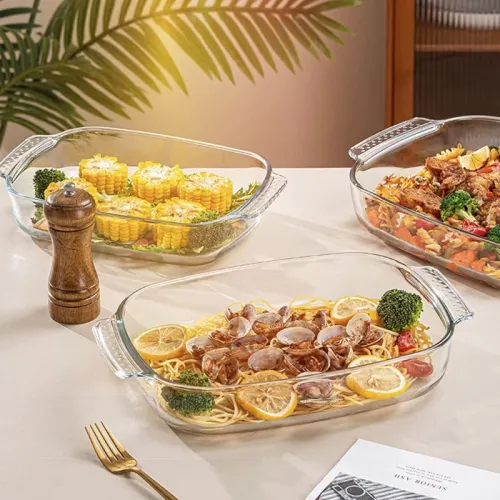 TEL: +86 311 67799298
TEL: +86 311 67799298 Email: tina@yintoglassware.com
Email: tina@yintoglassware.com
can i use glass tray for baking
Can I Use a Glass Tray for Baking?
When it comes to baking, the type of bakeware you use can significantly impact the outcome of your recipe. One common question among home bakers is whether a glass tray is suitable for baking. The short answer is yes, you can use a glass tray for baking. However, there are several factors you should consider to ensure the best results while maintaining safety in your kitchen.
Benefits of Using Glass Bakeware
1. Even Heat Distribution Glass bakeware is known for its ability to distribute heat evenly. This is especially beneficial for baked goods that require uniform cooking, such as casseroles or pies. As glass absorbs heat, it can help prevent hot spots, which can result in uneven baking and undesired textures.
2. Non-Reactive Surface Unlike metal pans, glass does not react with acidic ingredients like tomatoes or citrus fruits. This makes glass trays a good choice for recipes that include these ingredients, ensuring that your flavors remain intact and unaltered.
3. Versatility Glass trays are versatile and can be used for baking, serving, and storing leftovers. They can often transition directly from the oven to the table, which not only saves on dishes but also adds an appealing aesthetic to your meal presentation.
4. Visibility One of the advantages of using glass is that it allows you to monitor the progress of your bake. You can easily see the browning and cooking of your dish without having to open the oven and disrupt the cooking process.
Considerations When Using Glass Bakeware
can i use glass tray for baking

While glass trays have several advantages, there are also considerations to keep in mind to ensure successful baking
1. Temperature Sensitivity Glass is sensitive to temperature changes. Avoid placing a cold glass dish directly into a hot oven, as this can cause the glass to shatter due to thermal shock. Always allow your glass bakeware to come to room temperature before placing it in the oven. Similarly, do not place a hot glass dish on a cold surface, as this can also lead to breakage.
2. Baking Time Adjustments Baked goods in glass pans may require adjustments in baking time. Generally, glass pans promote slightly longer cooking times compared to metal pans. Keep an eye on your dish, as you might need to reduce the heat by 25°F (about 14°C) or extend the baking time.
3. Greasing the Pan Although glass is non-stick to an extent, it is still advisable to lightly grease or line your glass tray with parchment paper to prevent sticking, especially for items like cake or brownies. This will help in achieving a clean release, making it easier to serve and maintain the appearance of your baked goods.
4. Dishwasher and Oven Safe Most glass bakeware is dishwasher-safe and designed to withstand oven temperatures. However, always check the manufacturer's guidelines to ensure that your specific tray is safe for both dishwasher and oven use.
Conclusion
In conclusion, glass trays are a practical and effective option for baking. They provide an even cooking temperature, are non-reactive with acidic foods, and offer versatility for serving and storage. However, it is essential to be mindful of handling them safely, particularly regarding thermal sensitivities, appropriate baking times, and proper greasing techniques. By following these tips, you can make the most out of your glass bakeware and enjoy delicious, perfectly baked treats. Whether you’re baking a lasagna, brownies, or a stunning fruit crisp, a glass tray can be an excellent addition to your kitchen arsenal. Happy baking!
-
Benefits of Vacuum Containers with Pumps for Food PreservationNewsJun.12,2025
-
Glass Food Storage Container with Lid for Seal PreservationNewsJun.12,2025
-
Styling Amber Glass Plates for Modern TablescapesNewsJun.12,2025
-
Benefits of Double Wall Coffee Cups for Heat RetentionNewsJun.12,2025
-
Colored Glass Bowls in Cultural TraditionsNewsJun.12,2025
-
Durability of Colored Glass Dinnerware Compared to CeramicNewsJun.12,2025









